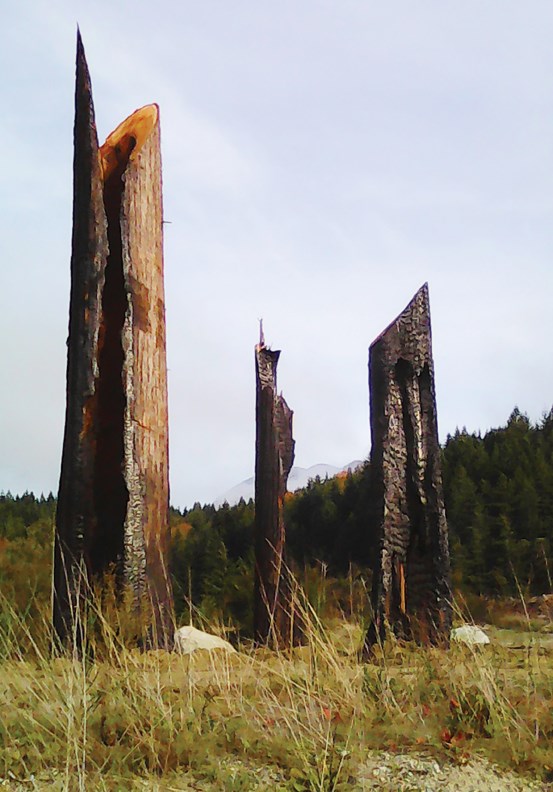Artist Gordon Halloran of Roberts Creek may be best known for his prominent and colourful ice sculptures displayed in public places to international attention. His latest project is closer to home and has so much more story behind it.
At the recent Sechelt Arts Festival viewers saw a small piece of it: two tall stumps, the charred remnants of the Old Sechelt Mine wildfire last summer, positioned sculpturally in place outside the Seaside Centre in a project he’s calling Regeneration and that is dedicated to the tree faller who lost his life fighting the fire, John Phare.
“The response has been amazing,” Halloran says. “When people see it, I don’t have to explain it to them.” For Coast residents, the memory of the fire that threatened our safety is still fresh in our minds. The two charred timbers are a grim, yet strikingly beautiful, reminder.
The Regeneration project proposes to grow new cedar seedlings within or around the stumps. The project is ongoing: the Seaside Centre sculpture might stay on its present site, council willing. A proposal is in the works to situate more trees at Hidden Grove, a heritage forest with trails open to the community, near Sechelt.
Last fall, SSC Properties, a multi-facility development on Porpoise Bay, and the Sunshine Coast Community Forest became sponsors of the Arts Festival and, through Halloran’s contact with the Community Forest’s Dave Lasser, he arranged for a crew of people to work at the forest fire site and select those burnt trees that could be installed as an art project on SSC’s land. Felling the charred trees and lifting them from the site involved a crew of fallers, helicopter pilots, crane operators, truckers, excavators, welders and engineering consultants – all paid in kind. It’s a dangerous job at the wildfire site – because the roots may be burnt underground, a strong wind will likely take more trees down.
A trio of stumps has already been rooted firmly in the ground in an undeveloped space at the SSC site, and they can be seen from across the water at the Lighthouse Pub. Halloran hopes to incorporate light in the installations so they can be seen at night.
Another jagged piece, its trunk hollowed and bark shattered, will soon join the others. Halloran doesn’t alter or burn the stumps. This is more about discovery, he explains, as he isolates pieces after searching for their interesting qualities. “The charred surface and the textures are fascinating to me. It’s more like curating than making art.”
After installing so much art around the world, travelling to Chicago, Niagara Falls, Turin in Italy and Richmond for the winter Olympic games, Halloran is delighted to be working at home.
“The opportunity for me to create public art is unparalleled,” he says. Also it’s slightly less anxiety producing than working with ice that is likely to melt before the big opening. “I call this the 1,000-year project,” he laughs. The regenerating seedlings could grow into cedar trees that last at least that long.
In the long term, the project is also a speculation on what might happen to all forests as the planet’s climate heats up. A future project he calls Black Forest proposes taking the stumps to Toronto, for example, and setting them up in a fountain at a public gathering place. The project would bring the forest to the city and up close to those who live in concrete and glass and who have never experienced the damage of wildfires.



